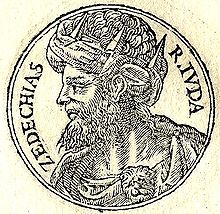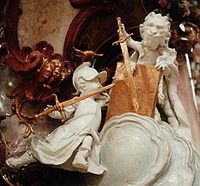Zedekiah: Difference between revisions
Enthusiast01 (talk | contribs) |
Enthusiast01 (talk | contribs) |
||
| Line 19: | Line 19: | ||
==Epilogue== |
==Epilogue== |
||
[[Gedaliah]], with a [[Babylonia|Chaldean]] guard stationed at [[Mizpah in Benjamin|Mizpah]], was made governor to rule over Judah |
[[Gedaliah]], with a [[Babylonia|Chaldean]] guard stationed at [[Mizpah in Benjamin|Mizpah]], was made governor to rule over Judah. ({{bibleverse|2|Kings|25:22-24|HE}}, {{bibleverse||Jeremiah|40:6-8|HE}}) On hearing this news, all the Jews that were in Moab, Ammon, Edom, and in other countries returned to Judah. ({{bibleverse||Jeremiah|40:11-12|HE}}) However, before long he was assassinated, and the population that was left in the land ran away to Egypt for safety. ({{bibleverse|2|Kings|25:26|HE}}, {{bibleverse||Jeremiah|43:5-7|HE}}) |
||
==Chronological notes== |
==Chronological notes== |
||
Revision as of 11:02, 26 February 2010

Zedekiah (Hebrew: צִדְקִיָּהוּ, Modern: Tzidkiyahu, Tiberian: Şidhqiyyāhû,"The LORD is my righteousness"; Greek: Ζεδεκίας, Zedekías; Latin: Sedecias) was the last king of Judah before the destruction of the kingdom by Babylon. He was installed as king of Judah by Nebuchadnezzar II, king of Babylon, after a siege of Jerusalem to succeed his nephew, Jeconiah, who was overthrown as king after a reign of only three months and ten days.[1]
William F. Albright dates the reign of Zedekiah to 597 – 587 BC, while E. R. Thiele to 597 – 586 BC.[2] On that reckoning, he was born c. 618 BC, being twenty-one on becoming king.
The prophet Jeremiah was his counselor, yet "he did evil in the sight of the Lord" (2 Kings 24:19–20; Jeremiah 52:2–3).
Life and Reign

Zedekiah was made king of Judah by Nebuchadnezzar II in 597 BC at the age of twenty-one and became a strong leader. The kingdom was at that time tributary to Nebuchadnezzar II. Despite the strong remonstrances of Jeremiah, Baruch ben Neriah and his other family and advisors, as well as the example of Jehoiakim, he revolted against Babylon, and entered into an alliance with Pharaoh Hophra of Egypt. Nebuchadnezzar responded by invading Judah. (2 Kings 25:1). Nebuchadnezzar began a siege of Jerusalem in January of 589 BC. During this siege, which lasted about thirty months, "every worst woe befell the devoted city, which drank the cup of God's fury to the dregs". (2 Kings 25:3; Lamentations 4:4, 5, 9)
In the eleventh year of Zedekiah's reign, Nebuchadnezzar succeeded in capturing Jerusalem. Zedekiah and his followers attempted to escape, making their way out of the city, but were captured on the plains of Jericho, and were taken to Riblah.
There, after seeing his sons put to death, his own eyes were put out, and, being loaded with chains, he was carried captive to Babylon (2 Kings 25:1–7; 2 Chronicles 36:12; Jeremiah 32:4,–5; 34:2–3; 39:1–7; 52:4–11; Ezekiel 2:12), where he remained a prisoner, how long is unknown, to the day of his death. Thiele has dated this event to 586 BC, while Albright dates it to 587 BC.
After the fall of Jerusalem, Nebuzaradan was sent to carry out its complete destruction. The city was plundered and reduced to ruins, being razed to the ground. Solomon's Temple was destroyed. Only a small number of vinedressers and husbandmen were permitted to remain in the land. (Jeremiah 52:16)
Epilogue
Gedaliah, with a Chaldean guard stationed at Mizpah, was made governor to rule over Judah. (2 Kings 25:22–24, Jeremiah 40:6–8) On hearing this news, all the Jews that were in Moab, Ammon, Edom, and in other countries returned to Judah. (Jeremiah 40:11–12) However, before long he was assassinated, and the population that was left in the land ran away to Egypt for safety. (2 Kings 25:26, Jeremiah 43:5–7)
Chronological notes
The Babylonian Chronicles give 2 Adar (16 March), 597 BC, as the date that Nebuchadnezzar captured Jerusalem, thus putting an end to the reign of Jehoaichin.[3] Zedekiah's installation as king by Nebuchadnezzar can therefore be firmly dated to the early spring of 597 BC. Historically there has been considerable controversy over the date when Jerusalem was captured the second time and Zedekiah's reign came to an end. There is no dispute about the month: it was the summer month of Tammuz (Jeremiah 52:6). The problem has been to determine the year. It was noted above that Albright preferred 587 BC and Thiele advocated 586 BC, and this division among scholars has persisted until the present time. If Zedekiah's years are by accession counting, whereby the year he came to the throne was considered his "zero" year and his first full year in office, 597/596, was counted as year one, Zedekiah's eleventh year, the year the city fell, would be 587/586. Since Judean regnal years were measured from Tishri in the fall, this would place the end of his reign and the capture of the city in the summer of 586 BC. Accession counting was the rule for most, but not all, of the kings of Judah, whereas "non-accession" counting was the rule for most, but not all, of the kings of Israel.[2][4]
The publication of the Babylonian Chronicles in 1956, however, gave evidence that the years of Zedekiah were measured in a non-accession sense. This reckoning makes year 598/597, the year Zedekiah was installed by Nebuchadnezzar according to Judah's Tishri-based calendar, to be year "one," so that the fall of Jerusalem in his eleventh year would have been in year 588/587, i.e. in the summer of 587 BC. The Bablyonian Chronicles allow the fairly precise dating of the capture of Jehoiachin and the start of Zedekiah's reign, and they also give the accession year of Nebuchadnezzar's successor Amel-Marduk (Evil Merodach) as 562/561 BC, which was the 37th year of Jehoiachin's captivity according to 2 Kings 25:27. These Babylonian records related to Jehoiachin's reign are consistent with the fall of the city in 587 but not in 586, as explained in the Jehoiachin/Jeconiah article, thus vindicating Albright's date. Nevertheless, scholars who assume that Zedekiah's reign should be calculated by accession reckoning will continue to adhere to the 586 date, and so the infobox below contains this as an alternative.
Genealogical note
Zedekiah was the third son of Josiah, and his mother was Hamutal the daughter of Jeremiah of Libnah, thus he was the brother of Jehoahaz (2 Kings 23:31, 24:17–18, 23:31, 24:17–18).
His original name was Mattanyahu (Hebrew: מַתַּנְיָהוּ, Mattanyāhû, "Gift of God"; Greek: Μαθθανιας; Latin: Matthanias; traditional English: Mattaniah), but when Nebuchadnezzar II placed him on the throne as the successor to Jehoiachin, he changed his name to Zedekiah. (2 Kings 24:17)
Zedekiah in the Book of Mormon
According to the Book of Mormon, Zedekiah's son Mulek escaped death and travelled across one of the oceans (Atlantic or Pacific) to the Americas, where he founded a nation that later merged with the Nephites.[5][6]
See also
- Jeconiah/Jehoiachin for more complete discussion of 587 vs. 586
- List of minor Biblical figures: Zidkijah
References
- ^ 2 Chronicles 36:9
- ^ a b Edwin Thiele, The Mysterious Numbers of the Hebrew Kings, (1st ed.; New York: Macmillan, 1951; 2d ed.; Grand Rapids: Eerdmans, 1965; 3rd ed.; Grand Rapids: Zondervan/Kregel, 1983). ISBN 082543825X, 9780825438257, 217.
- ^ D. J. Wiseman, Chronicles of Chaldean Kings in the British Museum (London: Trustees of the British Museum, 1956) 73.
- ^ Leslie McFall, “A Translation Guide to the Chronological Data in Kings and Chronicles,” Bibliotheca Sacra 148 (1991) 45.[1]
- ^ Helaman 6:10
- ^ Helaman 8:21
